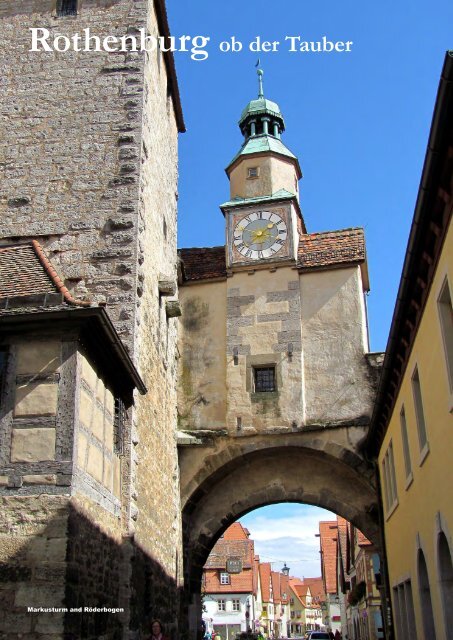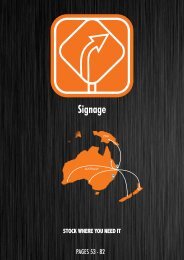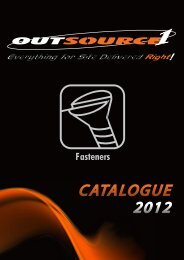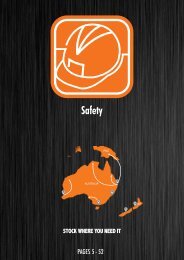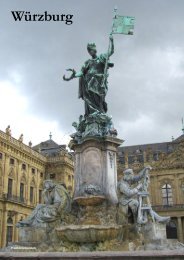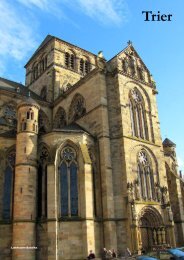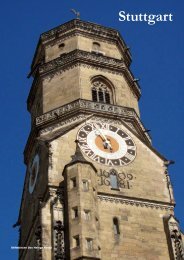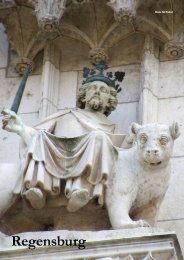Raven Guides: Germany - Rothenburg
You also want an ePaper? Increase the reach of your titles
YUMPU automatically turns print PDFs into web optimized ePapers that Google loves.
<strong>Rothenburg</strong> ob der Tauber<br />
Markusturm and Röderbogen
<strong>Rothenburg</strong> ob der Tauber<br />
Time passed <strong>Rothenburg</strong> by, but<br />
history did not leave it alone.<br />
After a medieval golden period the<br />
legacy of its later isolation was<br />
preservation, leaving travellers<br />
with a fully walled picture of the<br />
past and a rich stock of stories.<br />
Now a small town, <strong>Rothenburg</strong> was long an<br />
important centre close to key events. The<br />
location lent itself to a fortress and in the 11th<br />
century the first castle was constructed. It was<br />
handed to the imperial Hohenstaufen line in<br />
the 12th century and a bigger castle was built<br />
and used as a seat by Konrad, duke of Swabia,<br />
later king of <strong>Germany</strong> as Konrad III. The<br />
town proper was founded in 1170 and the first<br />
walls were built, later being twice extended. It<br />
soon found itself a junction of two pilgrimage<br />
routes, one between Denmark and Rome.<br />
In 1274 <strong>Rothenburg</strong> was granted the<br />
status of free imperial city, placing it directly<br />
under the emperor. In this period its Jewish<br />
community was prominent and one of the<br />
great medieval Jewish scholars, the rabbi Meir<br />
ben Baruch, lived in the town. But in 1298<br />
the town’s Jewish community fell victim to<br />
slaughter amid the hysteria of Franconia’s<br />
Rintfleisch massacres.<br />
An earthquake in 1356 destroyed the<br />
castle and damaged parts of the town. But it<br />
recovered and, during the late 14th century<br />
mayoral term of Heinrich Toppler, the town<br />
was one of the most populous in the Holy<br />
Roman empire.<br />
But Toppler’s independent policy made<br />
enemies, especially the prince-bishop of<br />
Würzburg. An alliance of enemies assaulted<br />
the town but was forced to retire and come<br />
to terms. Toppler, however, had fallen foul<br />
of town politics and was seized and jailed in<br />
1408. Two months later he died mysteriously.<br />
The peasant revolt of 1525 saw <strong>Rothenburg</strong><br />
on the losing side of the peasants. During the<br />
Thirty Years War the town was besieged three<br />
times and, according to tradition, its council<br />
was saved only by the ex-mayor Georg Nusch’s<br />
Meistertrunk, the long draught celebrated in<br />
the glockenspiel above the Marktplatz.<br />
Thereafter <strong>Rothenburg</strong> lost its importance.<br />
Its affluence gone, its burgers made do with<br />
their surroundings much as they were. But the<br />
value of its street environments and location<br />
were recognised and exploited for tourism in<br />
the 20th century and its unaltered state now<br />
attracts more than a million tourists a year.<br />
Heavy damage from a 1945 air attack was<br />
repaired with worldwide donations and now<br />
preservation laws protect building styles<br />
covering 500 years, including about 50 barns<br />
of various types and sizes, within the almost<br />
uniquely complete medieval walls.<br />
Altstadt<br />
The centre of the old town is a pedestrian<br />
zone for much of the day and walking is easy<br />
anywhere. Marktplatz (also signposted Markt)<br />
is the starting point for any stroll and in parts<br />
the parapets are accessible via stairways,<br />
notably around the southern gate Spitalbastei<br />
The Plönlein with the Siebersturm<br />
is the classic <strong>Rothenburg</strong> scene.<br />
and the nearby Spitalhof, the Rödertor on<br />
the east side and the Galgentor at the northeast<br />
end of Galgenstraße. Some of the older<br />
preserved buildings are in the Schrannenplatz<br />
precinct inside the north wall.<br />
Information<br />
The <strong>Rothenburg</strong> Tourismus Service office at<br />
Marktplatz 2 opposite the Rathaus is closed<br />
Sundays off-season, apart from short hours at<br />
Easter and during Advent Christmas markets<br />
late in November and during December. The<br />
website is www.tourismus.rothenburg.de.<br />
The Schöning Verlag City Guide<br />
<strong>Rothenburg</strong> ob der Tauber in English (€4.90)<br />
at more than 100 pages is an excellent colour<br />
guide to more than 30 locations in and around<br />
the town. Willi Sauer Verlag’s <strong>Rothenburg</strong> ob<br />
der Tauber Guide is also available at €4.90.<br />
The L. Pyczak Buchhandlung at Georgengasse<br />
9 has books and plenty of maps to browse<br />
through.<br />
Transport<br />
The main all-year transport link is the regional<br />
train shuttle between <strong>Rothenburg</strong> and Steinach<br />
RAVEN QUICK GUIDE<br />
Tourist information & accommodation service: Marktplatz 2 (tel 09861-404800, email<br />
info@rothenburg.de, May-Oct M-F 9-18, Sa-Su 10-17, Nov-Apr M-F 9-17, Sa 10-13).<br />
Money: Commerzbank, Galgengasse 23 (M, W & F 9-12.30, 13.30-16, Tu & Th 9-12.30,<br />
13.30-18); VR-Bank, Marktplatz 1 (M-F 9-12.30).<br />
Lockers: Bahnhof platform (€3/2 per day).<br />
Post: Zentro, Bahnhofstraße 4 (M-F 9.30-17, Sa 8-12).<br />
Internet: <strong>Rothenburg</strong> Tourismus Service, Marktplatz 2; Cafe Wunderbar, Spitalgasse 7<br />
(M-Su 10-19).<br />
Laundry: Wäscherei Then, Johannitergasse 9 (M-F 8-18, Sa 8-14).<br />
Police: tel 110; Ansbacher Straße 72 (tel 09861-9710).<br />
Pharmacy: Marien-Apotheke, Marktplatz 10 (M-F 8-18, Sa 8.30-13); Landwehr Apotheke,<br />
Bahnhofstraße 15 (M-Sa 8-20); Reichsstadt Apotheke, Ansbacher Straße 2 (M, W & F 8-18,<br />
Tu & Th 8-19.30, Sa 8.30-13).<br />
Ambulance: tel 112.<br />
Hospital: Klinik <strong>Rothenburg</strong>, Ansbacher Straße 131 (tel 09861-7070).<br />
(hourly, 15 minutes) to connect with mainline<br />
Frankfurt-Munich services. The station<br />
building is open short hours (M-F 8-18, Sa<br />
9-13) but tickets are available from a platform<br />
machine and there are outside lockers. The<br />
Deutsche Touring Romantische Straße bus<br />
departs (mid Apr-late Oct M-Su) north<br />
for Würzburg and Frankfurt and south for<br />
Dinkelsbühl, Augsburg and Munich, stopping<br />
at <strong>Rothenburg</strong> rail station (15.45 northbound<br />
and 12.55 southbound) and Schrannenplatz<br />
(16.35 and 12.50) at the north end of the old<br />
town.<br />
In summer Berlin Linien Bus runs<br />
Dresden-Bamberg-Würzburg-<strong>Rothenburg</strong> ob<br />
der Tauber-Ulm (W & Sa, return Th & Su)<br />
and Berlin-Bamberg-Würzburg-<strong>Rothenburg</strong><br />
ob der Tauber-Ulm (W & Sa, return Th &<br />
Su), stopping at the rail station. This service<br />
links with BLB buses running from Berlin<br />
and Leipzig. FlixBus has a direct service to<br />
Würzburg (and on to Berlin). To the south<br />
passengers have to change at Memmingen for<br />
Munich.<br />
<strong>Rothenburg</strong> is at the west end of the VGN<br />
transport network centred on Nuremberg.<br />
© 2014 RAVEN TRAVEL GUIDES GERMANY<br />
RAVEN TRAVEL GUIDES GERMANY - <strong>Rothenburg</strong> 1
Regional bus 814 connects <strong>Rothenburg</strong> and<br />
Dinkelsbühl, but there is no railway link.<br />
Connections with Nuremberg can be made<br />
using regional the trains, with changes at<br />
Steinach and Neustadt. The bus station is<br />
adjacent to the rail station platform. Tickets<br />
costing €10.10/5.10 (including bicycles) are<br />
valid for single journeys in the network for up<br />
to four hours. Day (or weekend) tickets for up<br />
to six people, including up to two adults (or for<br />
three people transporting bicycles) can use a<br />
TagesTicketPlus at €16.80. Visit www.vgn.de<br />
for details in English.<br />
In the north-west of the Altstadt (west<br />
of Weißer Turm and Markusturm and north<br />
of Wenggasse) there is a vehicle-free zone<br />
(M-Su 6-19, see town maps) and there are<br />
other restrictions on vehicular use at festival<br />
times. However car and parking permits are<br />
available from accommodation houses and<br />
large parking areas are outside the walls and at<br />
Schrannenplatz. The tourist information office<br />
can indicate relevant areas on a map. Taxis<br />
MUSEUMS<br />
The Doppelbrücke in<br />
the Tauber valley.<br />
queue at the rail station or can be ordered on<br />
tel 09861-7227 or 09861-2000.<br />
Bicycle hire is available at Rad & Tat<br />
(tel 09861-87984, M-F 9-18, Sa 9-13) of<br />
Bensenstraße 17 at €12 per day or €9 for six<br />
During December’s Christmas markets some attractions can be open slightly longer hours<br />
than normal winter times and it is worth checking with the tourist office. Key museums are<br />
open daily.<br />
The Reichsstadtmuseum <strong>Rothenburg</strong> (Apr-Oct M-Su 9-17, Nov-Mar M-Su 13-16,<br />
€4/3.50, families €8) in the cloisters of the former Dominican convent at Klosterhof 5<br />
contains medieval and Baroque collections, paintings from all periods including the<br />
<strong>Rothenburg</strong>er Passion (1494) by Martinus Schwarz, Renaissance armour and weapons<br />
including a matchlock musket more than 2m long, the Meistertrunk tankard and the<br />
equipped convent kitchen.<br />
The Mittelalterliches Kriminalmuseum (Apr M-Su 11-17, May-Oct M-Su 10-18, Nov-Mar<br />
M-Su 14-16, €5/3.50, families €13) in four storeys at Burggasse 3 is unique in its focus on<br />
the business of justice. Exhibits include bizarre and grotesque instruments of punishment,<br />
and fascinating insights into laws and sanctions from the 12th to 19th centuries with seals<br />
and documents.<br />
More tortures, cells and dungeons – and recreated scenes and history of the Thirty Years<br />
War period – are exhibited daily at the vaults of the Historiengewölbe mit Staatsverlies<br />
(Mar M-Su 12-16, Apr M-Su 10-16, May-Oct M-Su 9.30-17.30, Nov M-F 13-16, Sa-Su 10-<br />
16, €2.50/2, families €6) in the Rathaus courtyard (enter from Herrngasse). Here too is the<br />
cell where Heinrich Toppler was jailed in the 15th century. It is also open during Christmas<br />
markets – check with the tourist office for dates and times.<br />
Dolls and toys over three centuries are displayed at the Puppen & Spielzeugmuseum<br />
(Mar-Dec M-Su 9.30-18, Jan-Feb M-Su 11-17, €4/3.50, families €10) at Hofbronnengasse<br />
13. About 1000 dolls and their doll houses, clothing and other paraphernalia are included.<br />
The Alt-<strong>Rothenburg</strong>er Handwerkerhaus (Easter-Oct M-F 11-17, Sa-Su 10-17, Dec<br />
M-Su 14-16, €2.50/1.80) is in a building dating from 1270 at Alter Stadtgraben 26. Little is<br />
changed from the days it housed craftsmen at their work, with tools and household items<br />
from the 15th to 19th centuries.<br />
Christmas is celebrated all year at the Deutsches Weihnachtsmuseum (Mar-Dec M-Su<br />
10-17.30, mid Jan-Mar Sa-Su 11-16, €4/2.50, families €7) at Herrngasse 1. The museum<br />
runs in concert with the more commercial Käthe Wohlfahrt Weihnachtsdorf.<br />
The Rathaus (late Mar-early Oct M-Su<br />
9.30-12.30, 13-17) is in two parts. The earlier<br />
Gothic section (1380) includes the main<br />
Kaisersaal and tower (see Views). The<br />
Renaissance building (1578) replaced a section<br />
burnt in a fire in 1501 and includes the present<br />
main entrance facing the Marktplatz, although<br />
the arcades are 17th century additions. The<br />
stairway tower above leads to a hall flanked by<br />
the coats of arms of <strong>Rothenburg</strong>’s patrician<br />
families. The Swedish king Gustav II Adolf<br />
stayed in the building while occupying the town<br />
during the Thirty Years War. The portal to the older building shows a feature surviving on<br />
a few medieval town halls, the local measurement systems mounted as iron rods.<br />
hours, €10 per day for a week or more.<br />
Tours<br />
Daily guided 90-minute tours in English<br />
(Easter-Oct and Dec before Christmas, €7/4,<br />
children under 12 free) leave from the Rathaus<br />
main entrance at Marktplatz at 14.00.<br />
The idea of a nightwatchman tour is not<br />
unique to <strong>Rothenburg</strong> but the town has one of<br />
the best English tours of the type (one hour,<br />
Apr-Dec and early Jan M-Su 20, mid Jan-Mar<br />
Sa 20, €7/4, children under 12 free) with an<br />
entertaining mixture of history and humour,<br />
starting from the Rathaus entrance.<br />
An audio guide tour is available for up<br />
to four hours (€7.50) from the tourist office,<br />
telling a tale of 14th century <strong>Rothenburg</strong> from<br />
the imagined viewpoint of mayor Heinrich<br />
Toppler. Leaflets in English with two selfguided<br />
walks are also available at the tourist<br />
office.<br />
Coach rides along the Tauber valley with<br />
English commentary can be booked with the<br />
help of the tourist office.<br />
Views<br />
The overall view of the town is from the<br />
Rathaus tower climb (€2). The fee is paid<br />
near the narrow opening at the top after<br />
visitors negotiate a green-red light system in<br />
the upper hall.<br />
The tall Rödertor has accessible high<br />
gallery sections either side on the east wall.<br />
The tower of the fortified St-Wolfgangs-<br />
Kirche commands the north-west bastion<br />
precinct. There are superb views of the Tauber<br />
valley from the Burggarten and the sweep of<br />
the western walls allows excellent vistas of the<br />
north part of town, especially from the round<br />
Strafturm.<br />
A still wider landscape is available from<br />
the basket of a balloon. Happy Ballooning (tel<br />
09861-87888) at Spitalgasse 19 offers flights<br />
at €195, with group tickets from €160 per<br />
person.<br />
It is no vantage point but the mostphotographed<br />
scene in <strong>Rothenburg</strong> is at the<br />
street fork at the Plönlein, with the low road<br />
leading down to Kobolzeller Tor. Another<br />
is the half-timbered Gerlachschmiede near<br />
Rödertor.<br />
Parks & gardens<br />
<strong>Rothenburg</strong> in summer is crowded rather than<br />
bustling but the Burggarten is close at hand,<br />
outside the main walls with its blooms and a<br />
peaceful valley outlook. The area is illuminated<br />
at night. The walled Dominican Klostergarten<br />
(Apr-Oct M-Su 8-19) at Klosterhof maintains<br />
a herb garden on medieval patterns.<br />
Markets<br />
Christmas merges with the tourist industry in<br />
<strong>Rothenburg</strong> and the Advent Reiterlesmarkt<br />
(Su-Th 11-19, F-Sa 11-20) stirs many of the<br />
town’s attractions from winter hibernation<br />
from the last days of November until a few<br />
days before Christmas. In the best traditions of<br />
German Christmas markets these take place in<br />
Marktplatz against the illuminated backdrop<br />
of the Rathaus, offering trinkets, regional<br />
pastries and festive wine.<br />
Events<br />
The event of the year is the costumed<br />
Whitsun re-enactment in the Rathaus of the<br />
Meistertrunk of 1631, in which Georg Nusch<br />
<strong>Rothenburg</strong> 2 - RAVEN TRAVEL GUIDES GERMANY
The 12th century Burgtor with the town’s arms is the<br />
oldest and highest of the town’s gate towers. The<br />
Burggarten is the site of the Hohenstaufen castle (1142)<br />
built by Konrad III and destroyed by the earthquake of<br />
1356. The castle occupied what was before the<br />
development of the town a raised tongue of land<br />
dominating the Tauber. The keep or kernel tower was<br />
near the point to the south side. The remains of the castle<br />
were put to use in the town’s defences, except for what<br />
is now the Blasiuskapelle – now a war memorial – part<br />
of which survived the earthquake and was restored. The<br />
tower gate formerly had a drawbridge but the guardhouse<br />
and customs house remain.<br />
The 1492 St-Wolfgangs-Kirche (Apr-Sep W-M<br />
10-13, 14.30-17, Oct W-M 10-16, Dec Sa-Su<br />
11-16), also known as the Schäferkirche, is an<br />
example of a fortified church in a rare state of<br />
preservation. Right at the town’s northern gate<br />
Klingentor, its design merges with the bastion<br />
and had its own gun emplacements. But the<br />
defences go further, including a secret stone<br />
passage under the church that can be inspected<br />
by visitors. Before the church was built<br />
shepherds gathered at the site in worship of a<br />
shrine to St Wolfgang, protector of herds, and<br />
later returned annually in thanksgiving. The<br />
saint’s legends are depicted in the church.<br />
The Herterichsbrunnen depicting the triumph<br />
of St Georg and the Marien-Apotheke in the<br />
Jagstheimer Haus are at the head of<br />
Herrngasse, which preserves what was the<br />
top end of town in its heyday, a precinct of the<br />
fine houses and business headquarters of<br />
patrician late medieval citizens. This prime<br />
real estate adjacent to the Marktplatz and<br />
Rathaus includes the imposing Staudtsches<br />
Haus (Herrngasse 18), although the beautiful<br />
inner courtyards are not readily accessible. On<br />
some of the gables the beams still overhang<br />
from the days they were used for hoisting<br />
supplies to the roof cavities.<br />
The St-Jakobs-Kirche (consecrated 1464, M-Sa<br />
9-17.30, Su 10.45-17.30, €2/0.50) with its asymmetric<br />
towers, now the Evangelical parish church, marks the<br />
end of the St Jakob pilgrimage route from Speyer. As<br />
well as the saint, the visitor is in the presence of the<br />
great Würzburg sculptor Tilman Riemenschneider,<br />
whose Heilig-Blut-Altar (1505) upstairs, depicting the<br />
Last Supper, is among the great works of German art. It<br />
was commissioned for a reliquary cross venerated at the<br />
shrine of a chapel, probably the centre of a 13th century<br />
church. Riemenschneider or his school supplied two<br />
other altars, to the Virgin and St Franz. Part of the town<br />
has been painted into the high altar depiction of the<br />
saint (1467) by Friedrich Herlin.<br />
Every tower in <strong>Rothenburg</strong>’s walls<br />
would tell many stories. Weißer<br />
Turm bridging Georgenstraße marks<br />
the old inner-ring defences of the 12th<br />
and 13th centuries but has additions<br />
from the 18th century. Beside is the<br />
Judentanzhaus, a Jewish community<br />
centre, with a small memorial to the<br />
medieval Talmud scholar and<br />
<strong>Rothenburg</strong> rabbi Meir ben Baruch.<br />
Also aligned to the earliest stage of<br />
fortifications is the Markusturm on<br />
Hafengasse with its arch Röderbogen.<br />
is said to have met the challenge at a court<br />
martial held by the imperial field marshal<br />
Tilly to down a tankard at one gulp and save<br />
the town council from execution. Tickets are<br />
in three place categories (€14/14, €9/5 and<br />
€6/3.50). The festival includes other open-air<br />
activities during the week and a festival pass<br />
covering these admissions costs €12.<br />
Further performances of the play take<br />
place during the costumed Reichsstadt-<br />
Festtage weekend early in September and<br />
early in October. Tickets can be booked online<br />
at www.meistertrunk.de, where annual dates<br />
are provided. These events are accompanied<br />
by the folk custom of the shepherd’s dance<br />
or Schäfertanz in Marktplatz. It was said to<br />
drive away – and keep away – plague.<br />
In the first week of November the<br />
Märchenzauber draws on fairytale imagination<br />
for a series of evening events designed<br />
for all ages, but without a command of German<br />
only the music will be truly entertaining.<br />
Food<br />
Typical German fare is easy to find at the many<br />
Gasthöfe inside the walls and the bratwurst<br />
kitchens are several, though other cuisines are<br />
on offer. Restaurant Landsknechtstübchen<br />
(tel 09861-3323), Galgengasse 21, serves solid<br />
standard dishes from the German heartland,<br />
mostly under €12 for a main course.<br />
The tiny medieval tavern known as Zur<br />
Höll (tel 09861-4229) at Burggasse 8 by the<br />
west town wall revels in its devilish identity,<br />
serving a traditional repast in something<br />
approaching medieval surroundings.<br />
The sweet-toothed should not miss<br />
the chance to try the local pastry delicacy<br />
Schneeballen at a local Konditorei – just pick<br />
from whatever is on display. These balls of<br />
short-crust pastry strips can be brushed with<br />
sugar or glazed and flavoured with chocolate,<br />
nuts or even rum.<br />
Meet & drink<br />
Zur Höll (see Food) offers beers and<br />
Franconian wines. Cafe-Konditorei Uhl (M-<br />
Su 8-21) at Plönlein 6 under the Siebersturm<br />
serves coffee, icecream and Schneeballen as<br />
well as traditional Franconian meals next to<br />
the postcard landmark.<br />
Performance<br />
In St-Jakobs-Kirche there are about 100<br />
concerts through the year featuring the church<br />
organ and visiting ensembles and choral<br />
groups.<br />
Accommodation<br />
Family pensions and budget hotels are the<br />
mainstays of <strong>Rothenburg</strong> accommodation, part<br />
of a long tradition in which family businesses<br />
offer meals, cafe snacks or lodgings and<br />
often all three. Private hostels are few. The<br />
accommodation booking service at the tourist<br />
office has a list of private rooms but budget<br />
stays can easily be booked online by following<br />
the tabs at www.tourismus.rothenburg.de<br />
to the catalogue. Further budget rooms are<br />
listed online at www.deutsche-pensionen.de/<br />
pension-rothenburg.<br />
Inexpensive options are inside the town<br />
walls. Pension Hofmann-Schmölzer (tel<br />
09861-3371, www.hofmann-schmoelzer.de)<br />
at Rosengasse 21 offers singles/doubles with<br />
full facilities from €32/58 with breakfast and<br />
parking, plus a three-bed room at €82. The<br />
small Pension Birgit (tel 09861-6107, birgit-<br />
RAVEN TRAVEL GUIDES GERMANY - <strong>Rothenburg</strong> 3
Today’s Kapellenplatz was the centre<br />
of the old Jewish community and the<br />
synagogue site before it was banished<br />
outside the walls in 1390, after which<br />
the Marienkapelle was built. The Jews<br />
moved to the other side of the old wall,<br />
around Judengasse, and a synagogue<br />
was built at Schrannenplatz. Graves are<br />
in the small courtyard at the corner of<br />
Judengasse and Galgengasse under the<br />
tower, with a memorial to<br />
Holocaust victims. Much of this area<br />
was destroyed by 1945 bombing,<br />
including the second synagogue.<br />
The Roßmühle, now the main building of<br />
the DJH hostel, with its sweeping roofline<br />
and eyebrow dormers, once housed four<br />
large millstones and the 16 horses needed<br />
to drive them. This building supplied flour<br />
during sieges or when other<br />
circumstances dried up supplies from<br />
surrounding mills. Among nearby barn<br />
buildings the Zehntscheune (1699), later<br />
the Reichsstadthalle, one of <strong>Rothenburg</strong>’s<br />
biggest barns, was named for taking<br />
a tithe of one-tenth of the local grain<br />
supply. Part of the Spitalhof complex, it is<br />
now a conference venue.<br />
The powerful 16th century Spitalbastei is a complex<br />
on three levels involving multiple gates at the southern<br />
tip of the old town and visitors can walk around inside<br />
the bastion, where casemates and some of the defensive<br />
hardware in the form of cannon is still in place. The<br />
parapets of the defences are half-timbered and halfenclosed<br />
parapet walkways are accessible by steps. The<br />
area was part of later extensions to the town wall<br />
(previously gated at the Siebersturm) and the bastion<br />
was named for the much older Heilig-Geist-Spital, built<br />
outside the earlier wall circuit. The Spitalhof with the<br />
1281 Gothic Spitalkirche (M-Su 9-17, summer<br />
sometimes to 18.00) and the towered so-called<br />
Hegereiterhaus remain at the south end of Spitalgasse.<br />
A walk along Taubertalweg in the valley below<br />
<strong>Rothenburg</strong> leads to Heinrich Toppler’s 1388<br />
tower-style house, now called the<br />
Topplerschlößchen, is a 20-minute walk down a<br />
steep path from the Burggarten. It was reputedly<br />
elevated to allow for defensive flooding if<br />
necessary, which according to legend did not<br />
endear the mayor to many of the townspeople.<br />
A minute away to the south is the Fuchsmühle,<br />
one of the handful of late medieval mill buildings<br />
strung along the road heading south to the rebuilt<br />
medieval double stone bridge Barbarossabrücke.<br />
Another path leads back up to the town through the<br />
Kobolzeller Tor.<br />
pension.de) at Wenggasse 16 has singles with<br />
breakfast at €30, doubles from €40.<br />
Pension Becker (tel 09861-3560, www.<br />
pension-becker.com) at Rosengasse 23 has<br />
rooms with breakfast and all facilities starting<br />
at €28/48. Family rooms are also available.<br />
Close to but just outside the town is Hotel<br />
Klingentor Garni (tel 09861-3468, hotelklingentor.de),<br />
150m outside the north gate<br />
at Mergentheimer Straße 14, with singles/<br />
doubles including full facilities and breakfast<br />
starting at €38/65 and two and three-bed<br />
rooms starting at €65/95. Parking space and<br />
bicycle hire are free.<br />
A small family pension is Gästehaus<br />
Eberlein (tel 09861-4672, www.eberlein.<br />
rothenburg.de) at Winterbachstraße 4<br />
outside the town walls with singles at €45,<br />
doubles from €65, triples at €90. Walk about<br />
100m south-west from the station along<br />
Bahnhofstraße, left at Ansbacher Straße and<br />
right at Schlachthofstraße to sight the house.<br />
Traditional mill buildings in the Tauber<br />
valley below the town offer a different<br />
ambience. Pension Fuchsmühle (tel<br />
09861-92633, www.fuchsmuehle.de) is just<br />
across the river west of the town walls at<br />
Taubertalweg 103 (if on foot best reached<br />
from the Burgtor, although the path is steep).<br />
There are specials at the website and free<br />
beds for small children but standard bed and<br />
breakfast starts at €44/62 with three and fourbed<br />
rooms starting at €74 and €111. Extra beds<br />
cost €16 (plus €7 for breakfast). Apartments<br />
and a common room with library are also<br />
available. Pension Herrnmühle (tel 09861-<br />
2176, www.herrnmuehle-rothenburg.de) at<br />
Taubertalweg 54 has rates for a two-night<br />
stay starting at €34/54 a night with breakfast<br />
and full facilities, three-bed rooms starting at<br />
€90. Apartments for three nights or more are<br />
available. Expect a taxi fare of €8-10 to reach<br />
either from the rail station.<br />
The DJH hostel is Jugendherberge<br />
<strong>Rothenburg</strong> ob der Tauber (tel 09861-<br />
94160, email rothenburg@jugendherberge.<br />
de) in the old mill building Roßmühle at<br />
Mühlacker 1 at the south end of the old town,<br />
offering mostly dorm-style rooms but also<br />
several family rooms, doubles and triples with<br />
facilities. Bed rates start at €22.10.<br />
The Meistertrunk glockenspiel on the<br />
Ratstrinkstube at Marktplatz plays<br />
hourly (M-Su 11-15 & 20-22).<br />
A day excursion from <strong>Rothenburg</strong> is available at the Fränkisches<br />
Freilandmuseum (Mar-Apr Tu-Su 9-18, May-Sep M-Su 9-18, Oct-mid Dec<br />
Tu-Su 11-16), at Bad Windsheim, a short distance to the north-east. On one<br />
of the biggest open-air museums in Europe more than 100 Franconian rural<br />
and town buildings covering 700 years have been collected and restored,<br />
representing all classes, styles and purposes. The Spitalkirche, Alterbauhof<br />
and old pharmacy in the nearby town quarter can also be visited. Admission<br />
to all is €6/5, families €15. Take the DB regional shuttle train to Steinach<br />
and change for Bad Windsheim (20 minutes, check connections at<br />
<strong>Rothenburg</strong> station). From the Bad Windsheim station walk straight through<br />
the town centre to the south side and take Eisweiherweg to the museum’s<br />
entry complex. By road, pick up the A7 north to B470 and drive to Bad<br />
Windsheim, turning south at Südring, then Eisweiherweg.<br />
<strong>Rothenburg</strong> 4 - RAVEN TRAVEL GUIDES GERMANY


